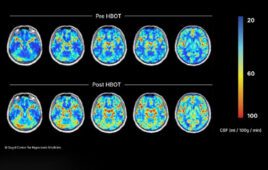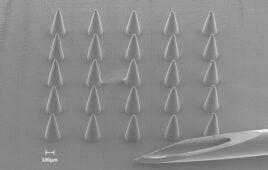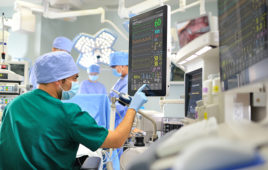
This is a surface and cross-section analysis of lyophilized scaffolds (A) and rehydrated scaffolds (B). (Credit: UPV/EHU)
Regenerative medicine is a discipline that is continually growing and encompasses a whole arsenal of therapeutic strategies, from recombinant proteins and stem cells right up to materials and matrices designed to release drugs and growth factors. The NanoBioCel group in the UPV/EHU’s Faculty of Pharmacy has developed one of these scaffolds, or matrices, for cases of critical bone defects, like those that can generate themselves in situations such as burns, injuries or tumour extractions; these scaffolds are designed to temporarily replace the matrix of the bone and help to regenerate bone tissue.
To make the material biodegradable and cut the risk of rejection, “we resorted to a by-product of collagen, a gelatin that is produced when collagen is processed, since it has been found to be less cytotoxic than the collagen itself, but retains the properties we were seeking,” explains Pello Sánchez, a member of the NanoBioCel group. Furthermore, for the polymerisation of the proteins in the gelatin and the cohesion of the scaffolding, they used a molecule extracted from genepin, the fruit of the gardenia “because it is less toxic for cells”.
Beyond the capacity to sustain mesenchymal stem cells, the ones responsible for regenerating the bone matrix, the researchers set out to render the material capable of retaining and releasing growth factors in the way and amount needed at each moment. This is because “it is the proteins that are capable of signalling to the cells what they have to do, and this improves the regeneration process”, explains the researcher. In their research, one of the most novel properties they were seeking was that “the scaffolding should have suitable release profiles in order to imitate what takes place in the body. We worked with two growth factors hugely important in bone regeneration, and we wanted there to be a release from one of them during the first two days following injury, and that the other should have a more sustained release”.
Promising results even in pre-clinical trials
Once the scaffolding had been designed, they subjected it to a range of tests and processes to explore its properties, biocompatibility and possible cytotoxicity. “The results were satisfactory in all the tests. In one of the tests the cells responded even better than expected: we had a carpet of cells grown in a conventional medium, and we placed the scaffolding on top of it to see whether the contact caused toxicity or cell death. When we lifted the scaffolding we saw that a gap had been created across the whole surface that had been in contact with it. Initially, we thought that cell death might have taken place, but then we realised that what had happened was that the cells had migrated to the scaffolding and that they preferred the gelatin to the plastic in which they had been grown,” says Sánchez.
With respect to the growth factor release profiles, Sanchez says, “we saw that the aim of imitating what takes place in nature was also achieved. The growth factor that was supposed to be released during the first few days was in fact released during the first 24 hours. It is SHH, a protein that is expressed at very specific moments and in very specific places and in very small amounts. In the cases of bone fractures it is only expressed during the first two days, and its function is to activate various genes present in the adjacent cells and which encourage bone regeneration.”
The second growth factor, VEGF, was also released in accordance with the way that this happens in the body. “In this case, it is a protein that causes angiogenesis, in other words, it causes blood vessels to be produced, and also attracts the cells to assist in the production of bone tissue”.
This study is the first part in a project in which preclinical studies in animals have already been conducted “with promising results which are in the process of being published. We have even proposed a new model for carrying out these tests in animals. From now onwards, we will be able to gradually improve what we have achieved so far, such as inserting other elements like calcium or other growth factors that enhance regeneration,” concludes the researcher.




